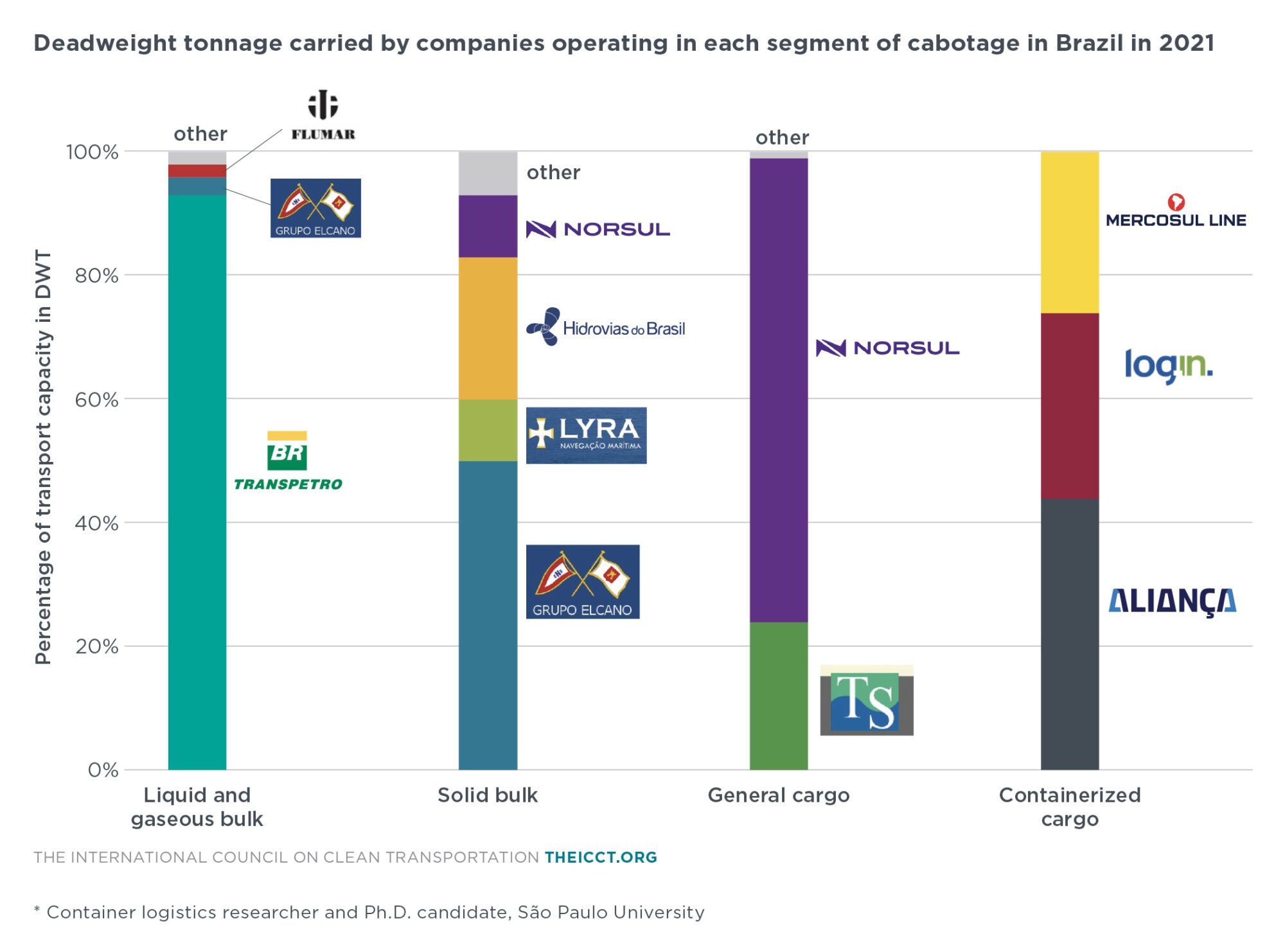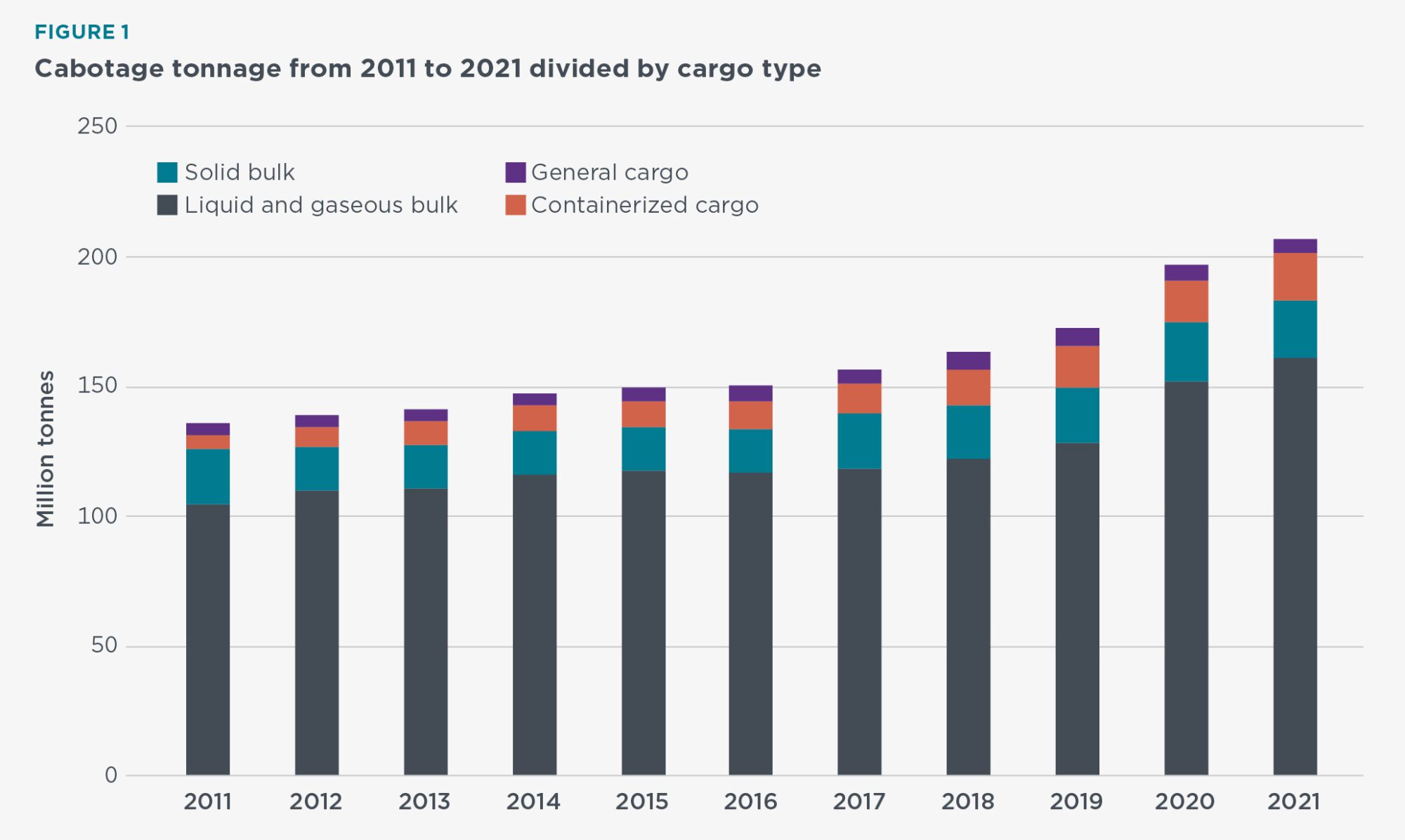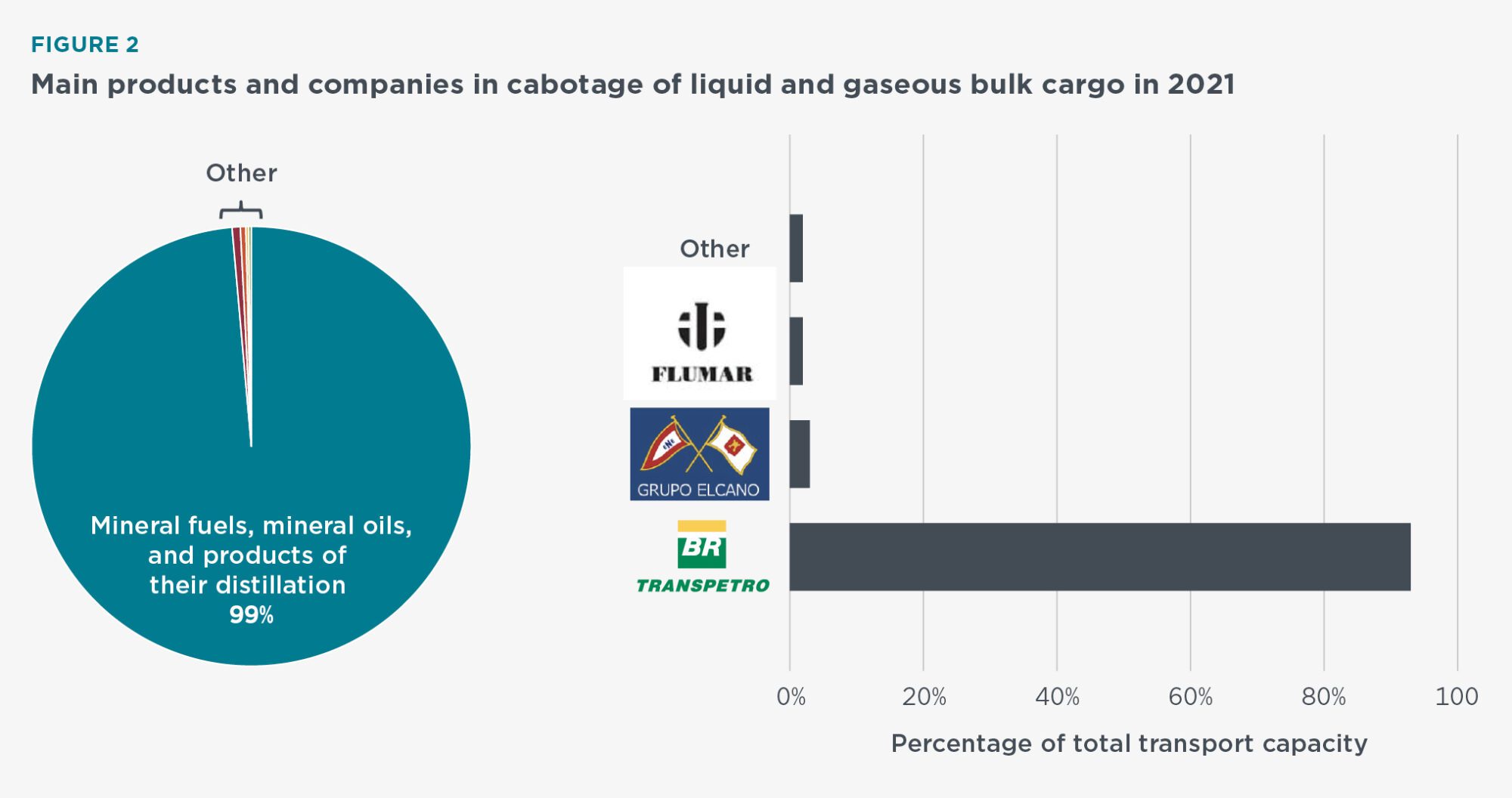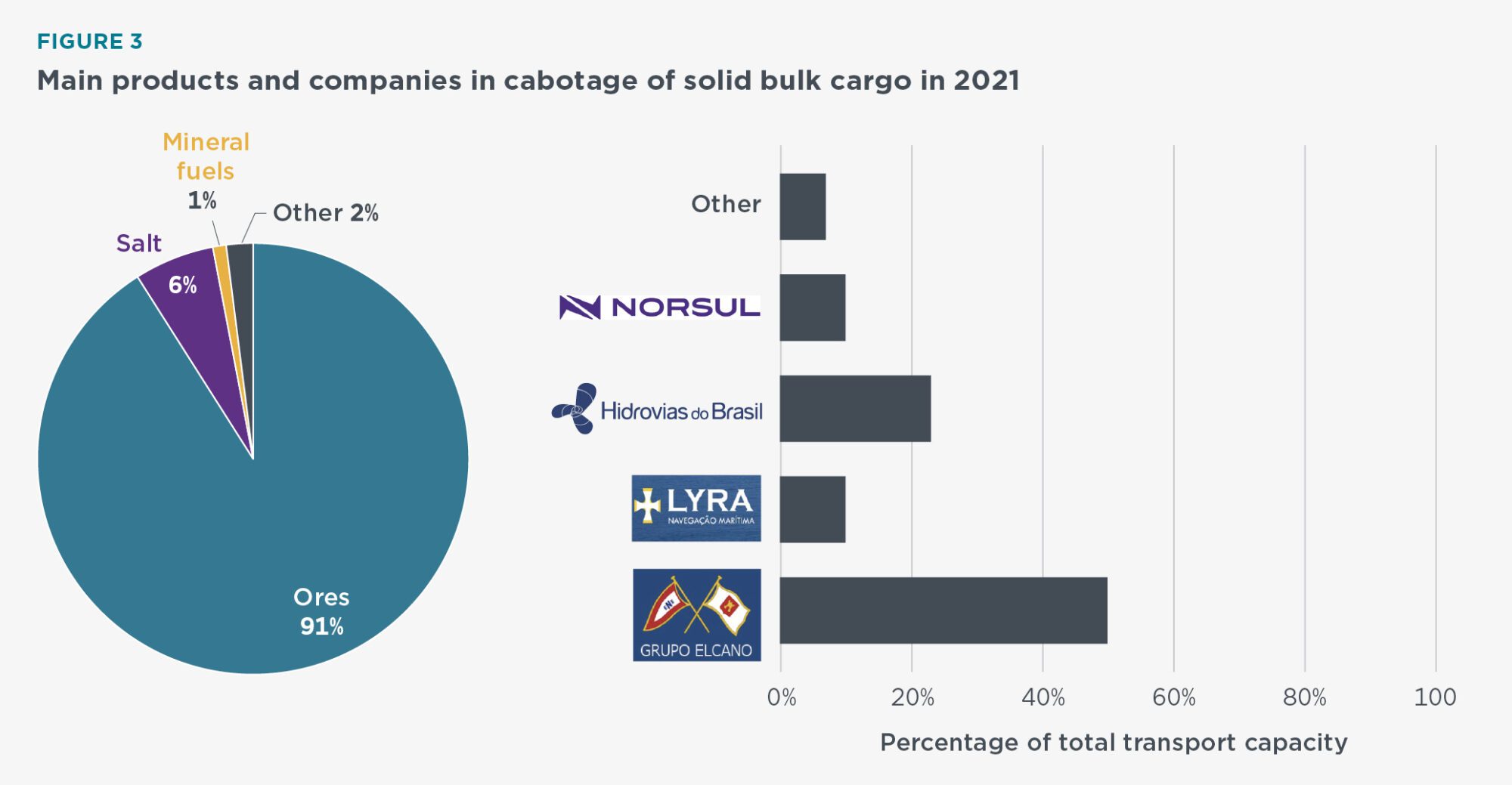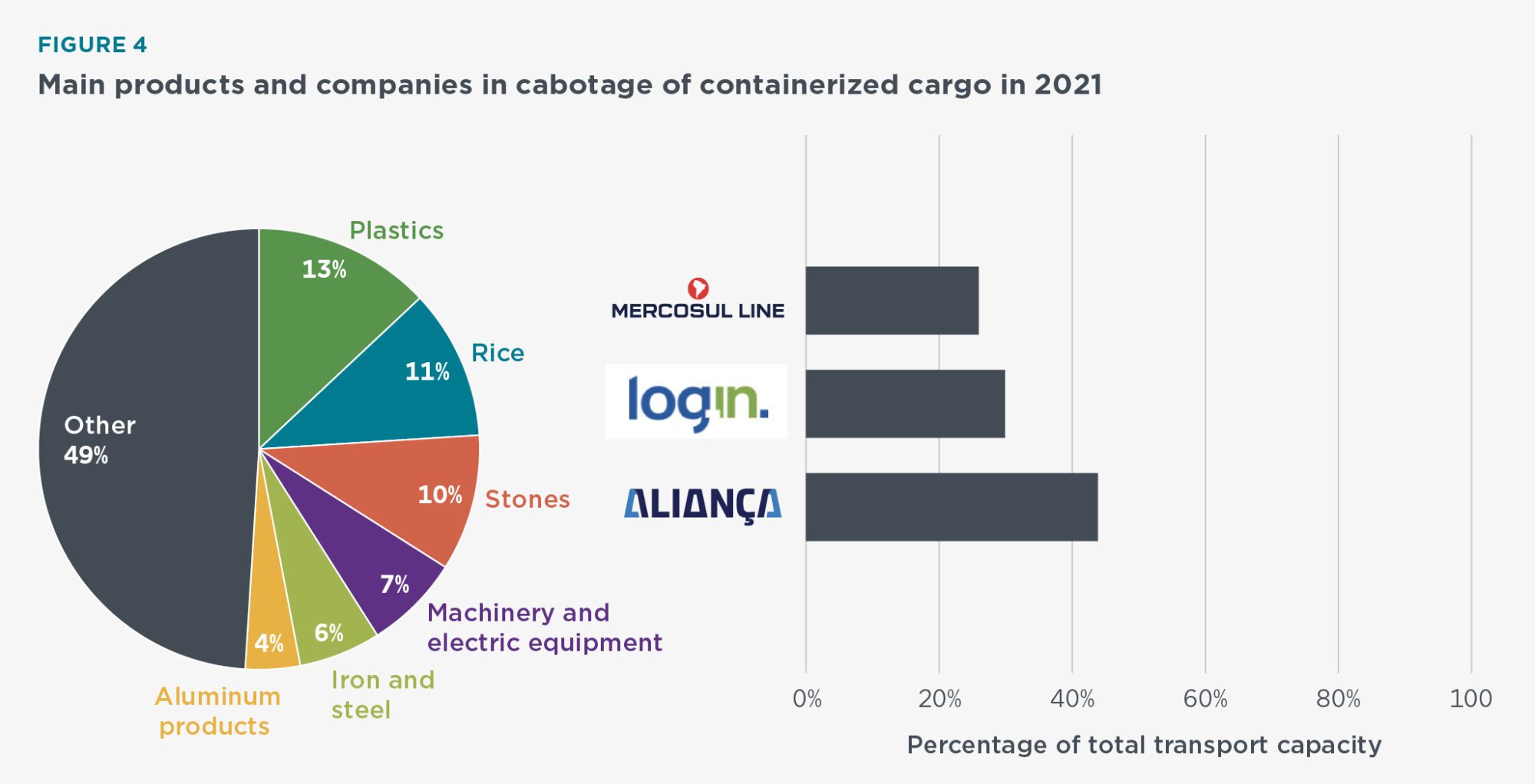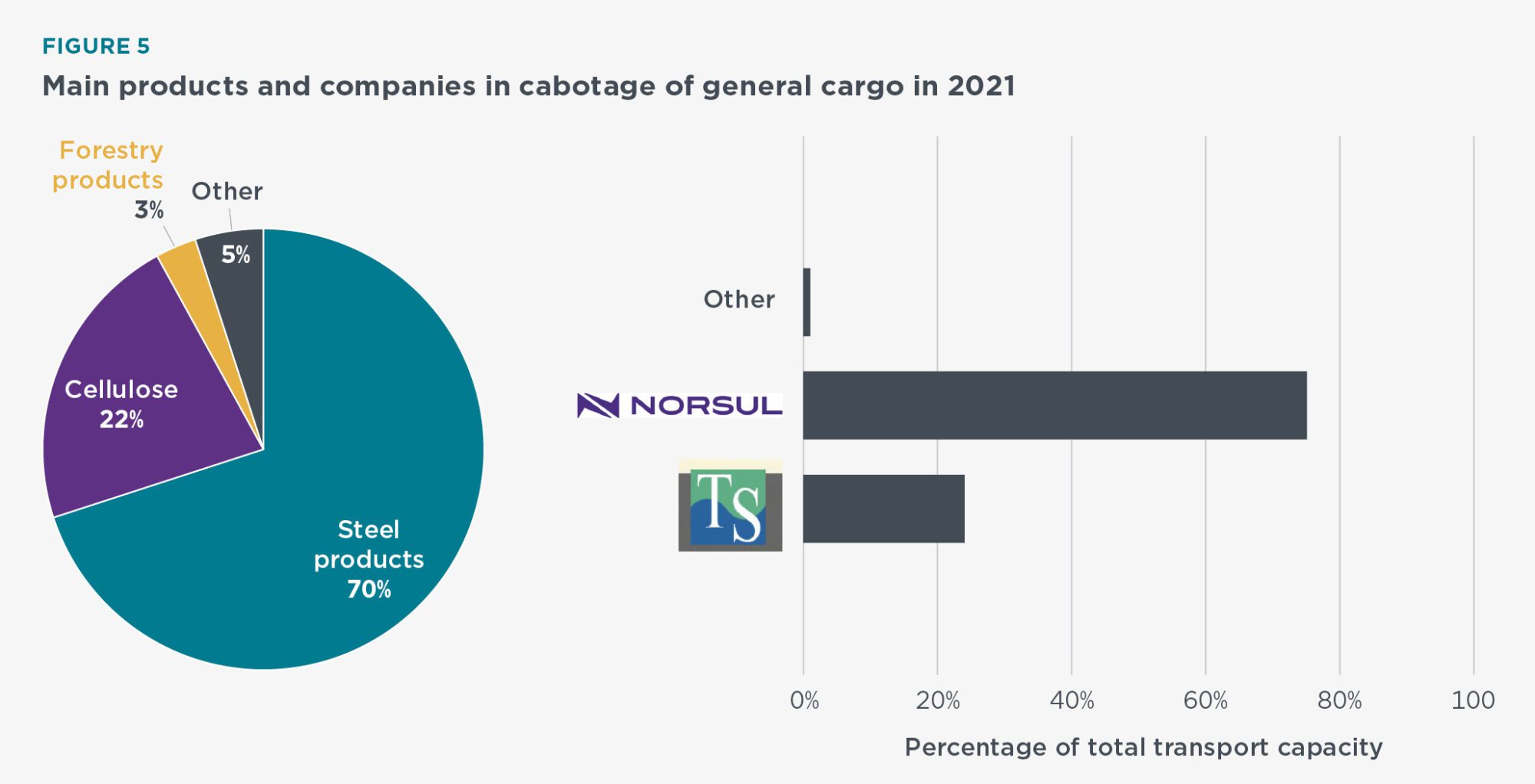Market Spotlight
Coastal shipping in Brazil in 2021
Like many countries, Brazil restricts shipping between domestic ports to domestic entities. Only Brazilian Navigation Companies, Empresas Brasileiras de Navegação (EBNs), can engage in cabotage.1 In mid-2023, Brazil’s National Agency of Waterway Transportation (Agência Nacional de Transportes Aquaviários or ANTAQ) showed 49 companies registered as EBNs that operate ships in cabotage.2 Here we highlight aspects of the market in 2021, when records show there were 185 ships in Brazil’s cabotage fleet; these were mainly barges, line handlers (vessels that unload oil from production and storage facilities to tankers, and from tankers to monobuoys), container ships, and tankers. About 60% of total transportation capacity was associated with the oil and gas industry. For all segments, a few companies owned most of the fleet and operations.
1 Lei No. 9.432, de 8 de janeiro de 1997, https://www.planalto.gov.br/ccivil_03/leis/l9432.htm.
2 See details of data sources.
Tonnage from 2011 to 2021
Liquid and gaseous bulk was about 77% of total cabotage tonnage in Brazil between 2011 and 2021, while solid bulk made up about 12% of tonnage, containerized cargo was 7%, and general cargo was 3%. Over this time, the tonnage of liquid and gaseous bulk grew by 53%, solid bulk tonnage grew by 7%, containerized cargo tonnage grew the most, by 230%, and general cargo tonnage grew by 10%.
Liquid and gaseous bulk
Of the liquid and gaseous bulk tonnes transported, 98.6% were mineral fuels, mineral oils, and products of their distillation. The remainder was organic chemicals (0.6%), inorganic chemicals and substances (0.4%), and beverages, liquor, and vinegar (0.2%). Most of this comes from offshore oil extraction platforms in Brazil’s Exclusive Economic Zone (EEZ) and the main destinations are the Southeast Region states of Rio de Janeiro and São Paulo, which are home to major oil refineries.3 Ten EBNs owned ships for transporting liquid and gaseous bulk; Petrobras Transporte S.A.—Transpetro had 68% of the fleet (26 ships) and 93% of the total transport capacity in this segment. Empresa de Navegação Elcano S.A. owned 16% of the fleet (six ships) and 3% of total capacity, while Flumar Transportes de Quimicos e Gases Ltda. had 5% of the fleet (two ships) and 3% of total capacity. Others had less than 1%.
3 Empresa de Pesquisa Energética, Balanço Energético Nacional 2022: Ano Base 2021 [Brazilian Energy Balance 2022: Year 2021] (Rio de Janeiro, 2022), https://www.epe.gov.br/sites-pt/publicacoes-dados-abertos/publicacoes/PublicacoesArquivos/publicacao-675/topico-638/BEN2022.pdf.
Solid bulk
The cabotage of solid bulk is strongly connected to the mining sector and the main products were ores (91% of total tonnes transported), salt (6%), and solid mineral fuels (1%). Solid bulk transport in cabotage is concentrated in the north of Brazil, and these shipments are mostly bauxite, the third most abundant natural resource in Brazil. Four companies engaged in cabotage of solid bulk. Elcano S.A owned 50% of the fleet (four ships) and had 56% of total transport capacity. Lyra Navegação Marítima owned 25% of the fleet (two ships) and had 10% of the transport capacity. Hidrovias do Brasil owned 13% of the fleet (one ship) and had 23% of total transport capacity, and Norsul owned 13% of the fleet (one ship) and had 10% of the transport capacity. As the transport of bauxite is based on long-term contracts and a dedicated fleet, there is little competition for the EBNs operating in this market.
Containerized cargo
Three EBNs operated in this segment and collaborated to offer multiple services: Aliança Navegação e Logística, Log-In Logística Intermodal, and Mercosul Line. They each had six ships registered. Aliança had 44% of transportation capacity, followed by Log-In (30%), and Mercosul Line (26%). All are subsidiaries of international corporations. Mediterranean Shipping Company (MSC) owns a majority stake in Log-in Logística Intermodal, Aliança is part of AP Moller – Maersk, and Mercosul Line is part of the CMA CGM Group. These EBNs offer feeder operations that transfer foreign cargo for import or export, an important part of cabotage services. Six products represented 51% of total tonnes of cabotage-related container cargo; these and 14 additional products represented 80% of total tonnes. Containerized cargo transport is more distributed throughout Brazil than the other cargo types. Main origin and destination points are in all regions along the coast.
General cargo
Since 2011, general cargo’s share of total cabotage tonnage in Brazil has steadily declined. Two products represent more than 90% of general cargo cabotage: steel products (70%) and cellulose (22%), the primary material for making paper. Forestry products such as wood and charcoal are third most common but represent only 3% of total tonnes transported. Ten ships and two EBNs provided 99% of the transport capacity: Tranship Tranportes Marítimos Ltda. owned five ships and had 24% of transport capacity, while Norsul owned two ships and had 75% of transport capacity. The main origins and destinations of general cargo cabotage are associated with steel products transported from Espírito Santo (Southeast Region) to Santa Catarina (South Region); forest products and cellulose transported from Bahia (Northeast Region) to Espírito Santo (Southeast Region), and steel products from Ceará (Northeast Region) to São Paulo (Southeast Region).
Investing in decarbonization
The BR do Mar program, embodied in Law No. 14.301/2022, updated legislation aimed at increasing the supply and quality of cabotage services in Brazil and promoting the competitiveness of EBNs, especially in the containerized cargo segment.4 Additionally, the company that owns and operates most of the ships operating in cabotage in Brazil, Transpetro, aims to reduce emissions from its ships by 11% and plans to invest BRL 64 million in decarbonization efforts by 2027.5 Among its planned projects, the company lists high-technology hull coatings to prevent fouling by marine organisms (thereby reducing fuel consumption and greenhouse gas emissions), use of advanced algorithms to identify the most efficient routes, optimization of main engine combustion, and use of biofuel blends.6 Furthermore, the major international container shipping companies that control or own companies operating in cabotage in Brazil have published sustainability goals; these goals include decarbonization of their global supply chains. The decarbonization goals published by the companies are included in Table 1.
Table 1. Major international container shipping companies’ decarbonization goals and their Brazilian subsidiaries
|
International corporation |
EBN subsidiary |
Decarbonization goals related to international maritime transport |
|
Mediterranean Shipping Company (MSC) |
Log-In |
Work throughout the MSC value chain to promote the investments needed to be carbon neutral throughout operations, develop logistical support solutions, and focus on energy efficiency. Work with stakeholders to promote the use of alternative fuels, including the necessary infrastructure and distribution systems. |
|
AP Moller – Maersk |
Aliança |
Decarbonization target for 2030 compliant with the Science Based Targets Initiative (SBTi) 1.5o C pathway to achieve absolute emissions reductions between 35% and 50% from a 2020 baseline; target of being carbon neutral by 2040 across all scopes and businesses. |
|
CMA CGM Group |
Mercosul Line |
The 2022 CSR Report said the company aimed to achieve net-zero carbon emissions for Mercosul Line by 2050, including having at least 10% of alternative fuels in its energy matrix by 2023, and reaching 100% renewable electricity in logistics warehouses by 2025. Pursue initiatives that include the use of alternative fuels in ships and designing ships with greater energy efficiency. |
As Brazil’s cabotage fleet primarily transports materials for the oil and gas industry, strategies to decarbonize national maritime transportation will require the participation and support of this sector. Recent analysis showed that supply and container vessels are the ship classes responsible for most of the emissions inside Brazil’s EEZ.7 The engagement of companies operating in the supply and container vessel segments will be crucial for the implementation of national decarbonization measures.
4 Lei No. 14.301, de 7 de janeiro de 2022, https://www.planalto.gov. br/ccivil_03/_ato2019-2022/2022/lei/l14301.htm.
5 Transpetro, “Transpetro Investe em Eficiência Energética e Descarbonização da sua Frota” [invests in energy efficiency and decarbonization of its fleet], news release, August 23, 2023, https://transpetro.com.br/transpetro-institucional/noticias/ transpetro-investe-em-eficiencia-energetica-e-descarbonizacao-da-sua-frota.htm.
6 Transpetro, Relatório de Sustentabilidade 2022 [Sustainability report 2022], https://sustentabilidade.petrobras.com.br.
7 Francielle Carvalho, Recommendations to Develop a Brazilian Maritime National Action Plan (Washington, DC: International Council on Clean Transportation, 2023), https://theicct.org/ publication/recommendation-to-develop-a-brazilian-maritime-national-action-plan-aug23/.
Data sources and methodology
The information presented in the figures was obtained from Brazil’s National Agency of Waterway Transportation (ANTAQ) databases. ANTAQ is responsible for regulating, supervising, and monitoring the activities of waterway transport services and port and waterway infrastructure operations. Two ANTAQ databases were consulted in April and May 2023: “Estatístico Aquaviário” [Waterway statistical panel], http://ea.antaq.gov.br/QvAJAXZfc/opendoc. htm?document=painel%5Cantaq%20-%20 anu%C3%A1rio%202014%20-%20v0.9.3.qvw&lang=pt- BR&host=QVS%40graneleiro&anonymous=true and “Navegação Marítima – Frota Geral – Analítica” [Maritime navigation – general fleet – analytics], http://web.antaq.gov.br/Portal/Frota/ ConsultarFrotaGeral.aspx.
Shipping companies’ websites were consulted, but when there were differences between the ANTAQ databases and companies’ reports, data from ANTAQ was prioritized. For example, there are differences between the container ship fleet data in ANTAQ’s databases and the information provided by the three EBNs on their websites. The information presented in this publication was from the ANTAQ database. For the general cargo fleet, we also found differences between ANTAQ data and companies’ websites. The ANTAQ database contains information about general cargo vessels that is mixed with barges that might not be operating in the general cargo sector. For example, although Tranship’s fleet is included in ANTAQ’s general cargo database, the company operates more in the oil and gas sector with open deck barges, according to its website.8
The ANTAQ database indicates that companies in the general cargo segment operate with open deck barges designed to transport special cargo rather than general cargo; some of these barges are associated with the oil and gas industry. Norsul’s website says that it operates in the general cargo segment with a fleet of barges and ocean pusher craft designed to transport cellulose and steel products.9 To be consistent with the other cabotage transport segments presented in this analysis, all data presented in the figures were obtained from ANTAQ database.
The ownership of the EBNs was sourced from the following:
- Michele Labrut, “Log-In Logistica Accept MSC Takeover Offer,” Seatrade Maritime News, December 23, 2021, https://www.seatrade-maritime.com/containers/log-logistica-accept-msc-takeover-offer.
- “Aliança—A Maersk Company,” accessed June 2023, https://www.alianca.com.br/a-alianca.
- “Especialistas em Cabotagem e Logística” [Specialists in cabotage and logistics], Mercosul Line, accessed June 2023, https://www.mercosul-line.com.br/.
8 “Frota” [Fleet], Tranship, accessed April 2023, http://www.tstranship.com.br/frota.html . The ANTAQ database indicates that companies in the general cargo segment operate with open deck barges designed to transport special cargo rather than general cargo; some of these barges are associated with the oil and gas industry. Norsul’s website says that it operates in the general cargo segment with a fleet of barges and ocean pusher craft designed to transport cellulose and steel products.9
9 “Navegação – Cabotagem e Longo Curso” [Navigation – Cabotage and Long Haul], Norsul, accessed April 2023, https://www.norsul.com/servicos/navegacao/.To be consistent with the other cabotage transport segments presented in this analysis, all data presented in the figures were obtained from ANTAQ database.

